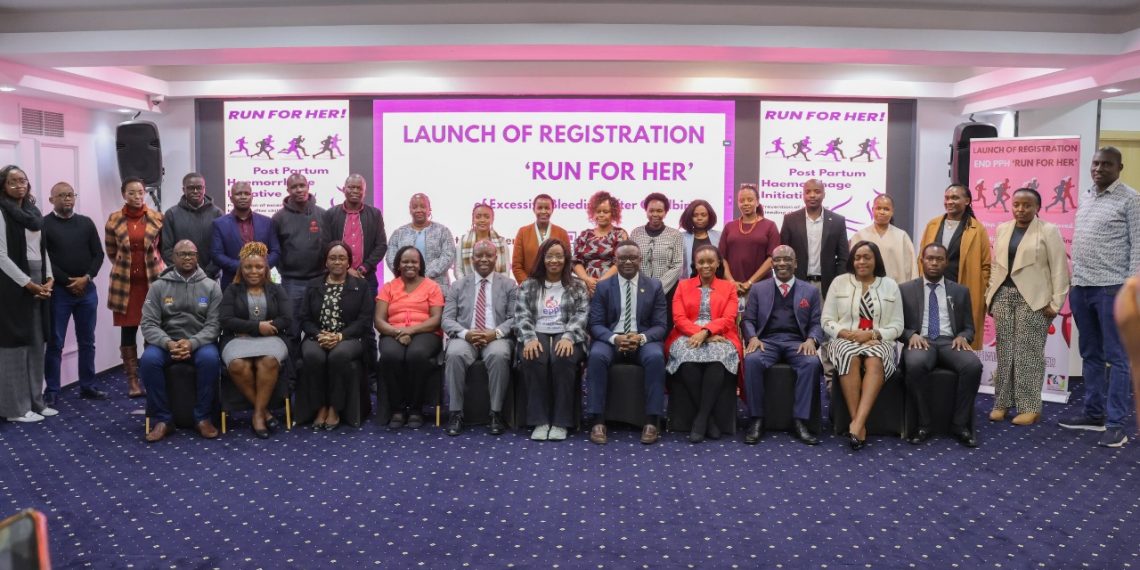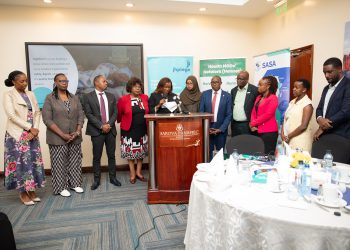In Kenya, where a mother’s journey to bring life into the world is often shadowed by the threat of death, a powerful movement is taking to the streets, on September 28, Kenya will hold the 2nd END PPH RUN in Nairobi at Ulinzi Sports Complex, Langata Road and five other counties- a critical campaign to combat postpartum hemorrhage (PPH), the leading cause of maternal death in the country.
The Run for Her initiative, organized by the University of Nairobi, the Kenya Obstetrics and Gynaecological Society, and the Midwives Association of Kenya and End PPH Foundation, is a concerted effort to save Kenyan mothers’ by addressing the severe lack of blood, weak infrastructure, and other systemic issues.
According to Moses Obimbo, a professor at the University of Nairobi, a Calestous Juma Fellow, and the lead of the EPPH Initiative and Run for Her, because of short supply of blood donations and donor dependency, Kenya’s blood supply has dwindled following the decline of donor funding from international organizations.
“This has led to a reliance on local donation, which has yet to meet the high demand. Hospitals across the country, especially in rural areas, report empty blood banks, leaving doctors powerless when faced with a bleeding mother. The “Run for Her” initiative aims to tackle this by creating a nationwide database of potential donors who can be mobilized for emergencies, reducing storage costs and ensuring blood is available where and when it’s needed,” Prof Obimbo explained.
Prof Obimbo expounded that ‘Run for Her’ is also meant to create awareness. “Understanding the problem is the first step to solving it, if someone sees a woman bleeding more than the equivalent of a packet of milk, they will know it’s excessive and that she needs urgent medical care, he said adding that “Awareness can also invite support from global stakeholders to fund programmes that prevent postpartum haemorrhage.”
Postpartum haemorrhage is the leading cause, accounting for 60 percent of maternal deaths. In Kenya specifically, about 2,500 to 3,000 women die annually because of postpartum haemorrhage, which is defined as excessive blood loss after childbirth. In a normal delivery, losing more than 500 milliliters (about the size of a packet of milk) is considered postpartum haemorrhage. After a caesarean section, losing more than 1,000 milliliters qualifies.
He says that causes of postpartum haemorrhage are preventable. Common causes include the uterus failing to contract after delivery, which accounts for 70 percent of cases; tears during delivery that lead to bleeding; retained membranes in the uterus; lack of blood clotting; and traction, where an unskilled birth attendant pulls the placenta too hard, causing the uterus to invert and bleed excessively.
“These causes are known as the five Ts of postpartum haemorrhage. Most of these causes should not result in death. “
However, there are challenges such as implementation gaps where trained staff fail to apply what they know at the point of care, unsustainable medication funding when donor programmes end, and lack of community engagement.
He says that the top five killers of women are postpartum haemorrhage, complications from hypertension during pregnancy (preeclampsia), unsafe abortion, infections during and after pregnancy, and obstructed labour, where babies cannot pass through the birth canal because they are too large or the mother is too small. A sixth rising cause is thromboembolism disorders, or clots during and after pregnancy.
Prof Obimbo added that the central issue driving Kenya’s maternal mortality is a severe lack of blood with an estimated 2,500 to 3,000 Kenyan women dying from PPH each year, a tragedy that is entirely preventable.
“In many cases, a woman’s life comes down to whether there’s a matching unit of blood on the shelf,” he states. “Too often, there isn’t.”
He explains that Kenya’s annual blood collection of 460,000 units meets only 60 percent of the country’s needs. “This deficit has worsened since donor funding began to decline.”
“The END PPH RUN aims to tackle this by creating a nationwide database of willing donors, essentially a “roaming blood bank” that can be mobilized for emergencies. “If we can mobilize communities to run for mothers, we can mobilize them to give blood for mothers. It is the difference between life and death,” Prof. Obimbo emphasizes.
Professor Julius Ogengo is leading Kenya Obstetricians and Gynaecological Society (KOGS) pilot study of a roaming blood bank, which aims at identifying people by blood group who can be called at any time to donate blood. This is a proof of concept that could be rolled out to other counties if successful.
The run will take place in six counties namely Nairobi County, Uasin Gishu County, where the running culture symbolizes mobilization of both rural and urban populations. Mombasa County has significant postpartum haemorrhage cases and strong leadership from Dr. Mitei Chepwogen. Kajiado County faces high teenage pregnancy rates, a major risk factor for maternal complications.
While blood is the most immediate need, the crisis is compounded by a weak healthcare infrastructure. “PPH needs blood immediately not after two or three hours when tragedy has already struck,” says Dr. Kireki Omanwa, President of the Kenya Obstetricians and Gynaecological Society. Many lower-level facilities lack ambulances or the necessary equipment, leaving mothers to die “on the road when they should already be on the operating table.”
“Women are not dying from unknown diseases. We know what is killing them and their newborns, but we have not made a deliberate decision to save their lives. If the national and county governments ring-fence funds specifically for maternal and newborn care money that cannot be diverted to other project, we could ensure quality medications, essential commodities, functional ICUs, and proper staffing. An ICU is not just a room; it must have equipment and trained personnel to care for mothers during the critical 24 to 48 hours after delivery.”
According to Dr. Kireki, saving mothers from preventable deaths requires a deliberate investment in five essential areas, which he refers to as pillars of care. First, human resources are critical, requiring well-trained and constantly refreshed medical teams. The second pillar is the availability of quality medications, such as oxytocin and tranexamic acid, which are vital for controlling bleeding.
“The third, and arguably most immediate, need is an adequate and accessible supply of blood for transfusions. The fourth pillar involves commodities, including surgical tools, uterine balloons, and emergency kits, which must be readily available. Finally, mothers need access to fully equipped ICU care with skilled staff for the critical 24 to 48 hours following delivery,” Dr. Omanwa warns that if “any one of these pillars is missing, mothers will be lost.”
Dr Kireki says that the challenge in Kenya isn’t just about the overall shortage of blood but also about the infrastructure and logistical failures that prevent it from reaching mothers in time.
“Ambulance services are also a problem,” he said adding “Many mothers die en route to referral hospitals because ambulances are unequipped. Mothers deliver in level 2, 3, 4, and 5 facilities, and even in dispensaries. When complications occur, there is often no ambulance at the lower-level facilities, and distances to higher-level hospitals can be daunting.”
Dr Kireki said that Kenya Obstetrics and Gynecological Society (KOGS), advocates for adequate ambulances, with trained drivers and fuel, but this is largely a matter of health financing. If a complication arises, the mother needs to be moved to the next level of care immediately. In some counties, mothers are driven 15 to 20 minutes to hospitals with theatres, but that critical time should have been spent on the operating table, not on the road.
“Every hospital where a mother deliver must have a dedicated theatre for caesarean sections. If mothers must be transported 20 or 30 minutes away for emergency surgery, we will continue to lose them.”
He says that Kenya lacks a culture of blood donation. “Even though blood transfusion centres are decentralized, they are not always where they are needed most. A mother may be bleeding in a sub-county hospital far from the nearest blood centre, and there may be no ambulance to collect blood. Postpartum haemorrhage requires blood immediately not after two or three hours, because by then tragedy may have struck.”
Dr Kireki says that technology could also help in transporting blood since some countries use drones, though Kenya has not adopted this approach yet.
The PPH crisis is not uniform across Kenya; some counties face greater challenges than others. Prof. Obimbo highlights 13 hotspot counties, including Garissa, which still struggles with weak infrastructure and scarce blood.
However, he also points to success stories like Makueni County, which has not lost a single mother to PPH in the past year due to its robust systems for medication access and emergency tools.
Last year, governors from Embu, Homa Bay, and Nakuru counties participated in the run, signaling high-level political support for addressing local maternal health needs.
Dr. Mitei Chepwogen, chair of the Coast Region of the Kenya Gynaecological and Obstetric Society, points out that the six coastal counties Lamu, Tana River, Kwale, Mombasa, Kilifi, and Taita Taveta are served by only a single regional blood transfusion center.
She is urging the government to establish more centers so each county can manage its own blood supply. “What’s even scarier is losing a mother during childbirth because there’s no blood available,” she states, hoping the upcoming “Run for Her” in Mombasa will encourage more people to donate.
“In the coastal region, an additional threat looms which is anaemia,” Dr. Mitei revealed adding that, “many pregnant women suffer from chronically low hemoglobin levels. By the time we see some mothers, there’s very little time left to correct low blood levels before delivery,” she says.
The devastating impact of a mother’s death extends far beyond one life. “Research shows that 35percent of babies whose mothers die will not survive to their fifth birthday,” Prof. Obimbo notes.
Prof Obimbo says that a robust data ecosystem is also needed to drive the campaign since outdated or missing data leads to wrong decisions. “The last demographic survey lacked maternal health indicators and maternal mortality ratios, which is a serious concern. This initiative also aims to strengthen data systems so we have real-time, accurate information for decision-making.”















